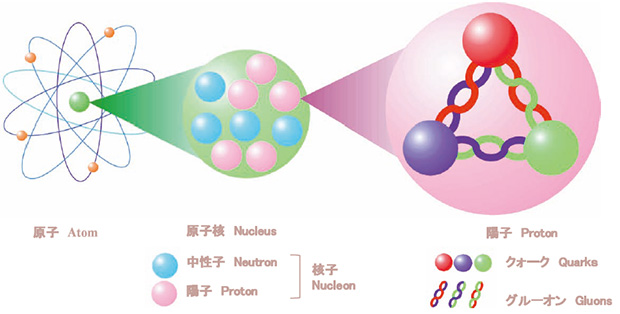 RIKEN BNL Research Center
RIKEN BNL Research Center

Quantum Chromodynamics
There are four forces in Nature: "gravity" as seen in celestial motion and described by the general theory of relativity; the "electromagnetic force" as seen in the interaction between the nucleus and electrons; the "weak force" which describes the beta decay of a nucleus (the "electromagnetic force" and the "weak force" are unified in the electro weak theory); and the "strong force" that acts between the quarks and gluons that form protons and neutrons.

Our research effort at the RIKEN BNL Research Center (RBRC) focuses on a wide variety of phenomena caused by the “Strong Force." These various and complex phenomena include the matter-creating process after the Big Bang. This “Strong Force" is described through a theory called QCD (Quantum Chromodynamics). We at RBRC are pursuing our research projects in order to elucidate various physical phenomena brought by the “Strong Force" from the principles of QCD.
The nucleus is at the center of the atoms that form all matter. The nucleons (protons and neutrons) are the components of the nucleus. This nucleon consists of quarks and gluons, the function of the gluons is to be the glue that binds the quarks. In a normal vacuum, quarks and gluons are bound by the Strong Force and "confined" in the nucleon.
This Strong Force has many very interesting characters; property called “asymptotic freedom” is that the force is relatively weak when quarks are close together, and becomes stronger and stronger when they are further and further apart, found by D.J. Gross, H.D. Politzer, and F. Wilczek (Nobel Prize in 2004). This property along with the prediction of “parity symmetry breaking” (Nobel Prize in 2008) by T.D. Lee, the Director Emeritus of RBRC, with C.N. Yang, are two of the foundations of contemporary particle and nuclear physics.
Other prominent properties of Strong Force include “Spontaneous symmetry breaking” (Nobel Prize in 2008) founded by Y. Nambu, as well as M. Kobayashi and T. Maskawa‘s “Charge-Parity symmetry breaking” (Nobel Prize in 2008), which plays an essential role in the search for the ultimate law of physics comprising gravity. All of these "symmetry breakings" in QCD (Quantum Chromodynamics) continue to be the grand theme of research conducted at RBRC.
RBRC Research Areas
-

Quantum Chromodynamics
Research into phenomena caused by the Strong Force
-

Spin Physics
Experimental attempts to measure quark and gluon spin and their distribution with the nucleon
-

Lattice QCD
A theoretical method to investigate the dynamics of QCD
-

Physics of QGP
Elucidating the nature of a form of matter called quark gluon plasma
